Visit the Painted Mosque in Tetovo From Skopje by Public Bus
In the foothills of the Šar Mountains, Tetovo’s Painted Mosque dazzles with colour, making it one of the most rewarding day trips in North Macedonia. I knew nothing about Tetovo before visiting North Macedonia, until a photo of an impossibly beautiful painted mosque stopped me in my tracks. Discovering it was only a short bus ride from Skopje sealed the deal: a day trip was too tempting to pass up. Here’s everything you need to know about visiting Tetovo from Skopje.
Planning a Trip To Tetovo? Here’s Where You’ll Find Things
And here’s some more from North Macedonia on the One Small Bag if you’re interested.
This guide may include a few affiliate links. If you choose to buy something through one of them, I may earn a small commission (at no cost to you). Thank you for supporting One Small Bag and helping keep this resource ad-free and independent.
Is Tetovo worth visiting?
Tetovo is definitely worth visiting. It’s a city in the North-western part of North Macedonia in the foothills of the Šar mountains. With the Pena river running through, it’s a spectacular setting which reminds me of Prizren in Kosovo. That’s maybe not surprising, given they are both in the foothills of the Sar mountains. Just on different sides of them. But the main reason you would want to visit Tetovo is to see the Painted Mosque (Šarena Džamija).
Tetovo is a 50 minute bus ride from Skopje city centre. Just off the main road between Skopje and Ohrid and 2 hours away from Prizren in Kosovo. So it’s well connected and easily visited from these three cities.
Tetovo in Context: History & People
Tetovo has been settled since medieval times, but it really grew under the Ottomans, who left their mark with mosques, hammams, and bazaars. Today, Tetovo is North Macedonia’s sixth-largest city, with around 63,000 residents. It’s one of the most diverse places in the country: Albanians make up about two-thirds of the population, Macedonians just over a fifth, with Roma, Turks, and others adding to the mix.
Tetovo is often described as the cultural heart of the Albanian community in North Macedonia, with Albanian-language signs, probably more common than Cyrillic script. It’s also an academic hub, home to two universities, and a gateway to the Šar Mountains and the ski resort of Popova Šapka. That mix of cultures, politics, and geography makes it a city of real importance – and one that feels very different to Skopje.
How To Visit The Painted Mosque in Tetovo
Here’s the details of our journey which I hope, together with the map, will be useful to you, if you plan to visit Tetovo too.
Skopje to Tetovo By Bus
Skopje Bus Station and Buying Tickets
There’s scant information online about the bus service from Skopje to Tetovo. I found a timetable on Balkan Viator which is a bus aggregator, holding bus times for a number of routes in the area. You can’t book tickets online, but there’s a ticket office at Skopje Coach Station which you’ll find underneath the arches of the railway station. Be aware there are two different areas underneath the train station. You’re looking for the part of the station with full size long distance coaches and a covered waiting area with seating and a proper ticket office. If you are in the stands for the red double decker city buses, you’re in the wrong place.
We went prepared to buy tickets with Google Translate, but the lady smiled at the question on my phone and answered in perfect English, issuing paper tickets. You can buy them in advance at the bus station or on the day, which ever works for you. Purchasing with a payment card is possible, but there are several operators running the route, so I’d carry cash (MKD) just in case there are individual differences.
Possibly a recent development, because I really didn’t spot it when we booked, but there is currently one bus in and out of the city each day, you can purchase online through Flixbus. The times may not suit, but if you’re anxious about the bus trip, it’s definitely an option to consider for one or both ways.
Bus Information
- From: Skopje’s main coach station (under the railway station)
- To: Tetovo (multiple daily departures)
- Time & Cost: around 40–50 minutes; fares typically €2–5 one way depending on operator.
- Frequency: buses run roughly every 30 minutes throughout the day, first out 04:15, Last back 21.55 – according to the timetable, which I would not 100% rely on – but should be little chance of getting stranded
Reviews of the bus station are pretty dire! Dirty station, fees added to access the platform as well as the toilet plus a less than stellar service. All I can say is we found it fine. I’ve seen worse at Paris Bercy and after the ‘platform ticket purchase drama’ we experienced in Belgrade, this was a walk in the park by comparison! It was more straightforward than buying tickets for the local buses in Skopje for Mount Vodno! – different process – check the link ).

Check the Wiring!

While opinions on the station are variable, our bus was a full size coach, clean and modern and with a toilet on board too.
We also took a peak upstairs to look at the rail station. It was absolutely deserted. There are a few local services and no International ones running to Skopje. A reminder that buses are often your best bet in the Balkans as trains to many places may be rare or non existent.

Bus Journey to Tetovo
The bus arrived and left on time. Part of the journey was on a toll road which was a good one. The journey was comfortable and lasted about 50 minutes. And what a view as we drove towards the Sar mountains!
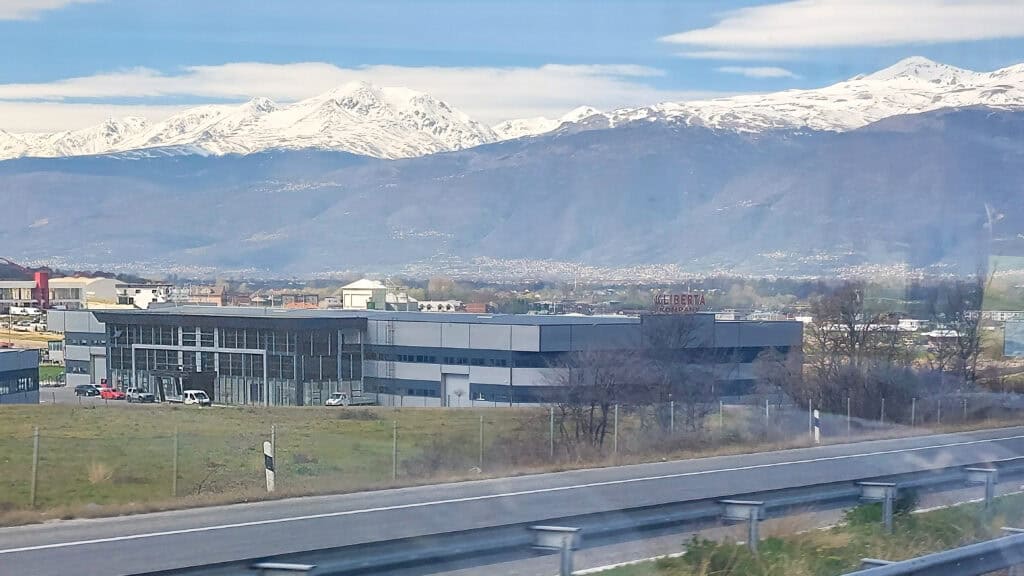
The bus station in Tetovo is a little way out, but we didn’t wait for the final stop. We followed the crowds getting off the bus in the centre at the roundabout and green market. For the return journey we walked to the bus station to be sure of catching the bus back.
Tetovo Map With Walking Route
Here’s a walking route with the main things you are likely to want to see in Tetovo. I’ve also added our coffee stop and late lunch stop. Both were excellent, but not the only options in Tetovo. The route marked is 6km, so very ‘doable’ in a day.
First Impressions of Tetovo
We arrived to stalls on the pavement and many more in the Green Market. Pigeons (?) in cages and live chickens wandering about, contemplating their fate no doubt! I’m not quite sure what we were expecting, but it felt pretty incongruous compared to the mosque we were searching for.
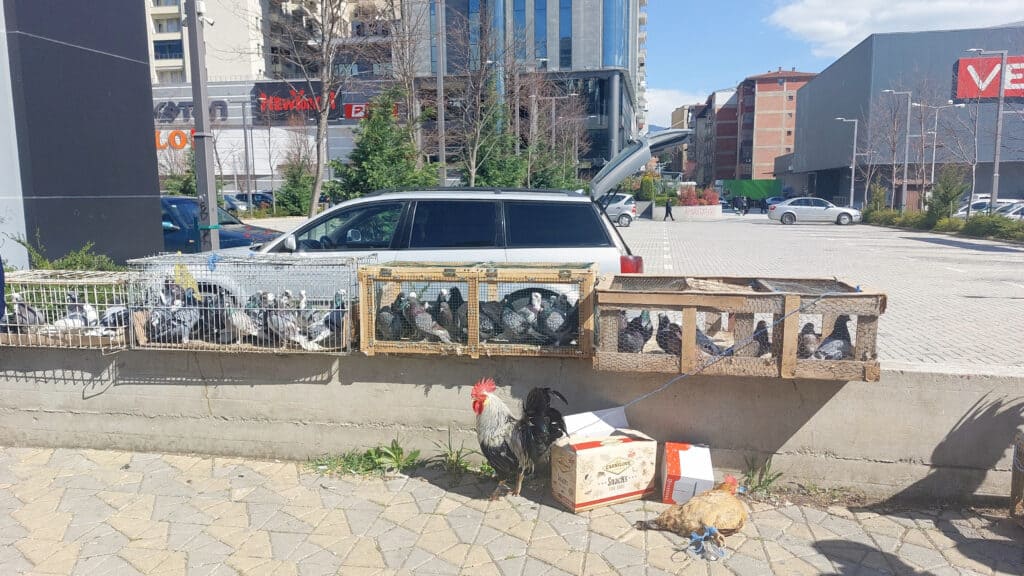
But any mild panic was quelled when we stopped off for some coffee. Sach Coffee – great espresso, modern, designer surroundings, breakfast cake, excellent Wi-Fi, and staff genuinely happy to see us. A league apart from your average Starbucks!
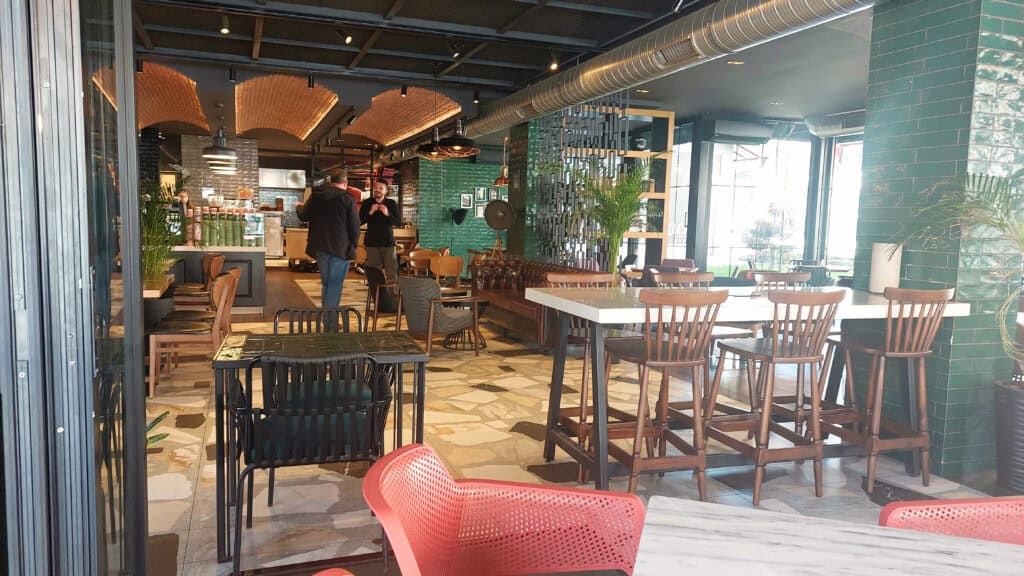
After the coffee stop, it was another minute or two up the road, a left turn and we arrived at the mosque. (See Map – for route).
🌍 Exploring this region?
Here are more ideas and nearby destinations worth adding to your itinerary:
• Best Things to Do in Skopje: Your Comprehensive Travel Guide to Europe’s Most Kitsch Capital
• Visit the Millennium Cross and Mount Vodno from Skopje by Public Bus
• 23 Best Things to Do in Bucharest – and One I’d Avoid Right Now
The Painted Mosque
It’s certainly one of the most beautiful mosques in Macedonia, if not Europe. It has a number of names, the Sarena Mosque (Šarena Džamija), Colorful Mosque, Painted Mosque, Pasha Djamija (Prince’s Mosque) or Motley Mosque.
From the street, the Painted Mosque looks more like a grand Ottoman house than a place of worship: low, rectangular, with a tiled roof and colourful exterior walls. The setting, with the Šar Mountains rising in the distance, makes the whole ensemble even more dramatic.
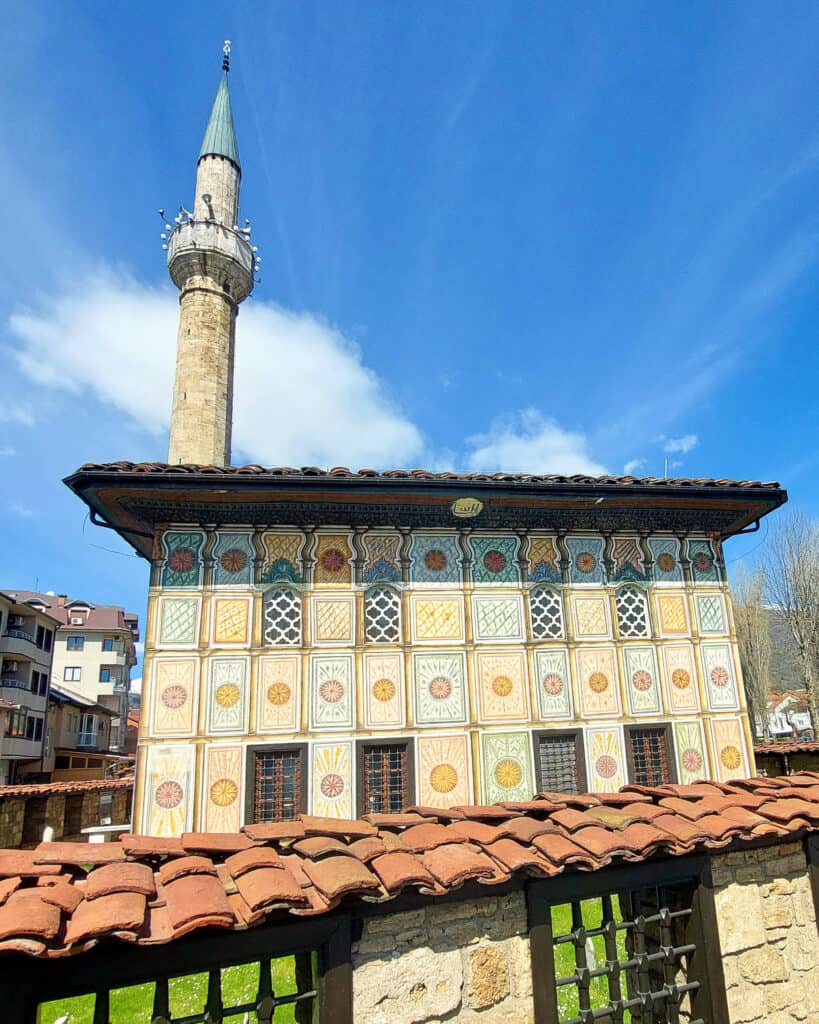
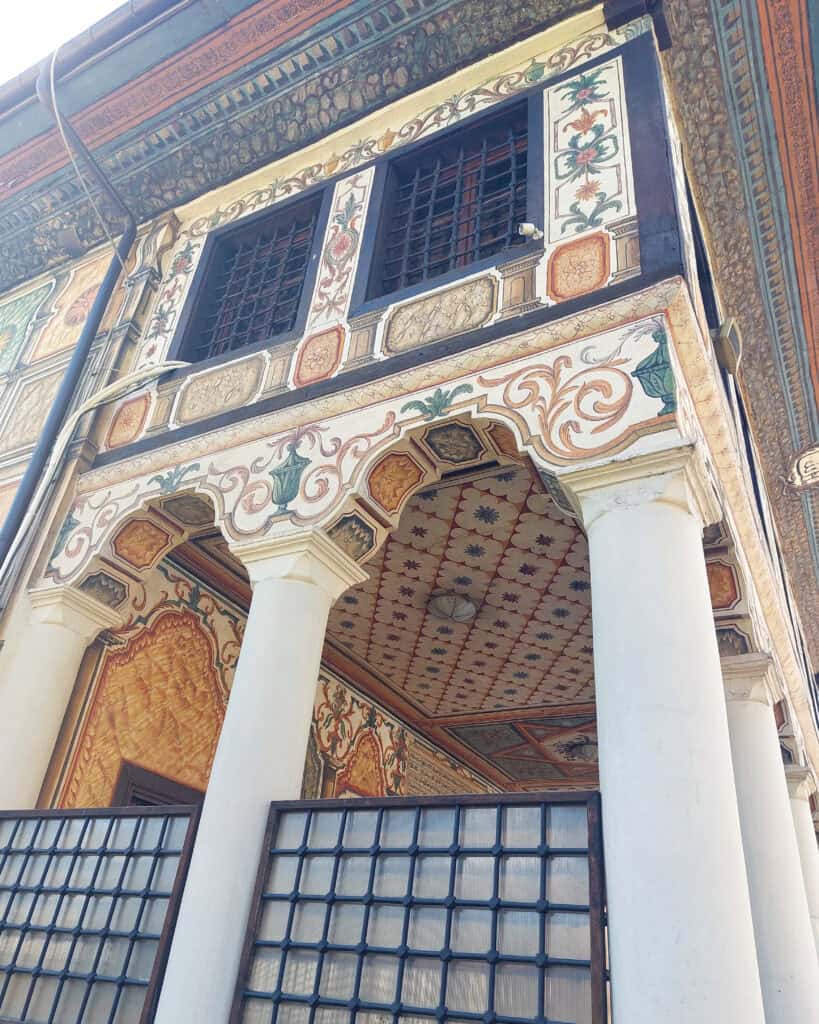
History of Tetovo Mosque
The Painted Mosque was first built in 1438, during the early Ottoman period, and was unusual from the start. Instead of being funded by a sultan or pasha, it was financed by two local sisters – making it one of the rare examples of female patronage in Islamic architecture. The mosque was later expanded in the 19th century under Abdurrahman Pasha, when many of its colourful designs were refreshed.

Tetovo Mosque Frescoes
Step inside and you’re met with walls, arches, and ceilings covered in paint. Instead of the intricate tilework seen in Ottoman mosques further east, this one is a canvas of bold floral patterns and geometric designs. You’ll find painted panels, depicting landscapes, cities, and even the Kaaba in Mecca. In total, there are thought to be over 30,000 individual details painted across the surfaces. The frescoes use vivid natural pigments and allegedly 30,000 eggs were used to produce the yellow paint. The layering gives the mosque a unique, almost kaleidoscopic atmosphere. It’s a riot of colour that feels more like a Renaissance chapel than a typical mosque interior.
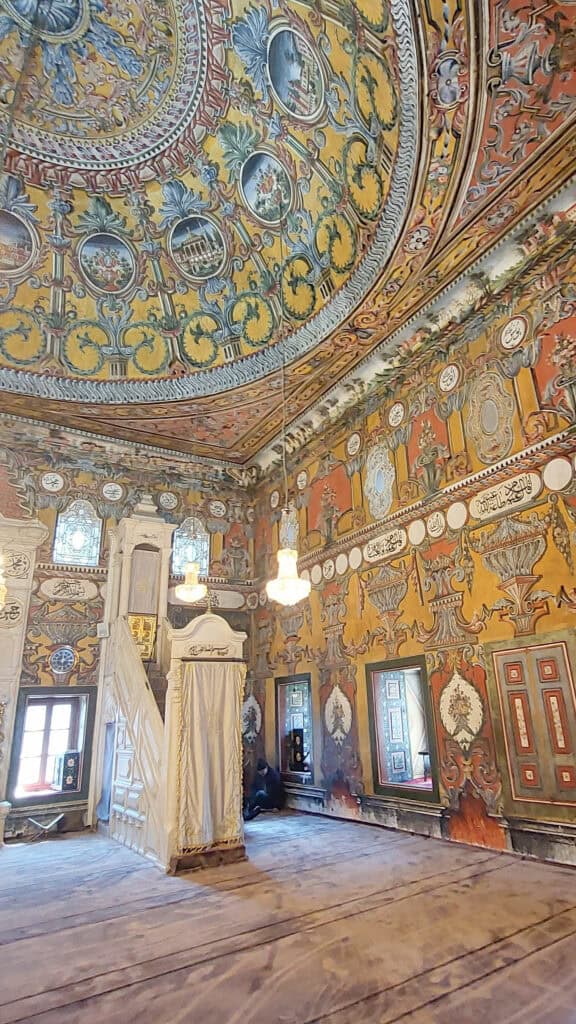

(Upstairs is for Women)
Other Features of Tetovo Mosque
Look beyond the frescoes and upwards and you’ll spot the balconies. These are for women to watch events downstairs. They have a separate area upstairs. You’ll also find a finely carved mihrab (prayer niche), and stained glass windows that soften the light inside.
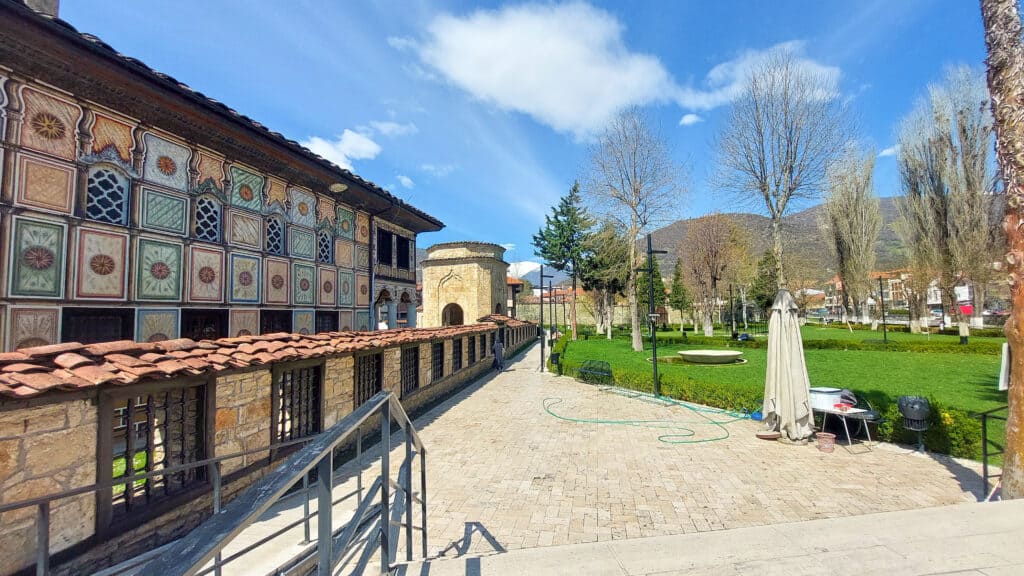
Tetovo Mosque Courtyard
The mosque complex sits in a beautiful courtyard and gardens. It includes a türbe (tomb) for its patrons, keeping the sisters’ story woven into the site. In the courtyard you’ll also find a fountain for ritual washing beneath an ornate wooden canopy, often the first thing you’ll see as you step through the gate.
Tips for Visiting The Mosque
- Opening hours: There isn’t a strict tourist schedule — it’s an active mosque. Avoid prayer times (particularly Fridays around midday) or be prepared to wait.
- Entry: Free, though donations are appreciated.
- Dress code: As with any mosque,, cover shoulders and knees; women should bring a scarf. Take your shoes off.
- Photography: We were warmly welcomed and encouraged to take photos, but be polite and ask first.
- How long to allow: Around 30–45 minutes to explore inside and out at a relaxed pace.
Tetovo Art Gallery
The bath house (Haman) on the other site of the river Pena used to be part of the complex of the Sarena Mosque. The bath house now houses the Tetovo Art Gallery. It’s a small contemporary art space with exhibits including paintings, graphics and photography, changed periodically. The building itself – a late 15th-century twin-domed bath house, is a good reason to pop in too.
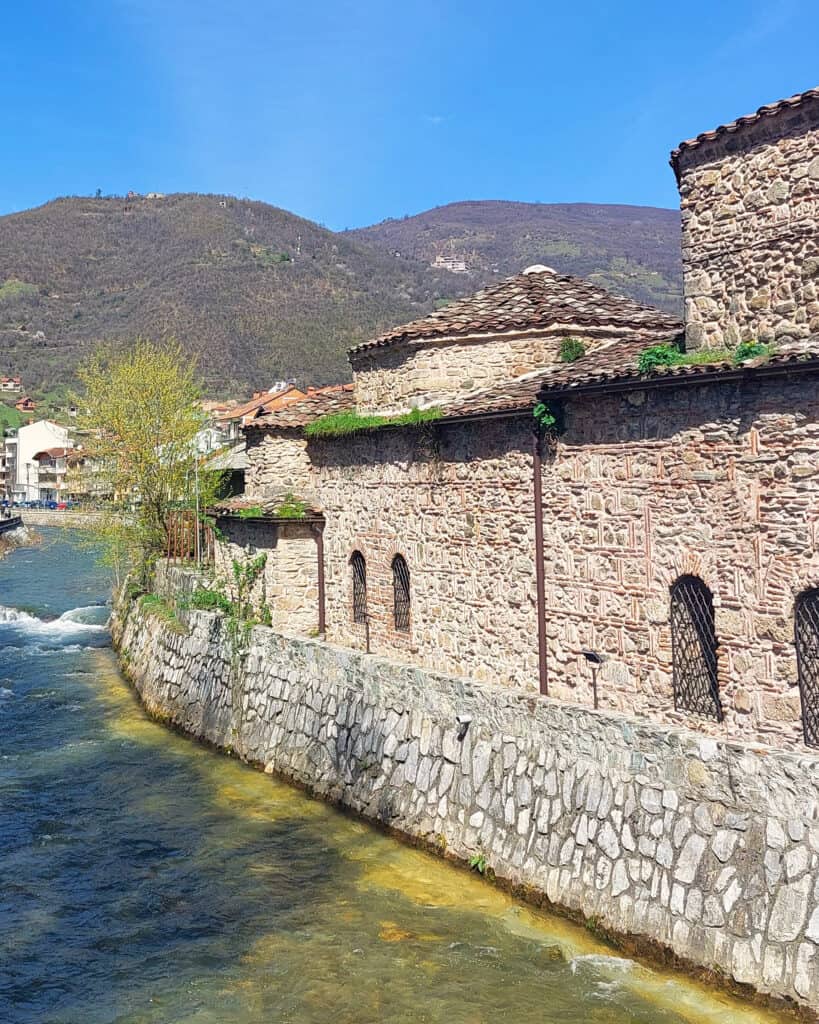

If you stand on the bridge, looking towards the art gallery and river, with the Pena river as a backdrop, it certainly makes a good photo stop. And if you turn around on the bridge, you will see the next view point of interest on our map, the Old Stone Bridge.
Old stone bridge
This was built in the 15th century. It spans the Pena River with a simple single arch. It’s not as big or dramatic as, say Stari Most, in Mostar, but together with the Painted Mosque and hammam it anchors Tetovo’s Ottoman core. Another opportunity for a photo!

And here’s some more from North Macedonia on the One Small Bag if you’re interested.
Arabati Baba Bektashi Tekke
Once you have seen everything in the mosque area, the next place to see is Arabati Baba Bektashi Tekke which is another 10 mins or so along the road It’s considered one of the best conserved tekkes in Europe. The present structure is from the late 18th century but the site dates back to 1538. It is a walled complex with an impressive gate.
What is a Tekke?
A tekke is a lodge used by Sufi dervishes — mystical brotherhoods within Islam. They served as places of worship, learning, and hospitality across the Ottoman Balkans.
- Arabati Baba Tekke (Tetovo, North Macedonia): Founded in the 1500s by the Bektashi Order. The Bektashis remain especially strong among ethnic Albanians in North Macedonia, Albania, and Kosovo – so the tekke reflects the city’s Albanian identity as much as its Ottoman past.
- Blagaj Tekke (Mostar, Bosnia & Herzegovina): – a more well known Tekke in the Balkans. It’s a little different. It’s built by the Halveti Order, another Sufi tradition, its spectacular cliffside setting makes it one of the most visited tekkes in the Balkans.
There are many other Sufi brotherhoods — including the Mevlevi (the Whirling Dervishes of Konya, Turkey), the Naqshbandi, and others – each with their own tekkes. What unites them all is the idea of a spiritual lodge where prayer, music, study, and community life come together.
Take Time to Explore
Frequently, I find it’s the little things I remember about places, not just the ‘big ticket’ items I came to see. The funny, the unusual, the fascinating or down right weird all have their place, creating memories. There’s always something. And Tetovo’s no exception. If you rush, you simply miss ‘all the things’.
So here, in the ‘fascinating’ category, we have the gold shops of Tetovo. It wasn’t what I was expecting in a place which isn’t fancy – painted mosque excepted. Look out for the intricate gold necklaces, traditionally worn at weddings or festivals to display wealth and craftsmanship. You’ll see versions in ethnographic collections across the region but they’re on display in a number of shops on the main street in Tetovo too.

Here are some choices for the ‘funny’ and ‘weird’ categories.

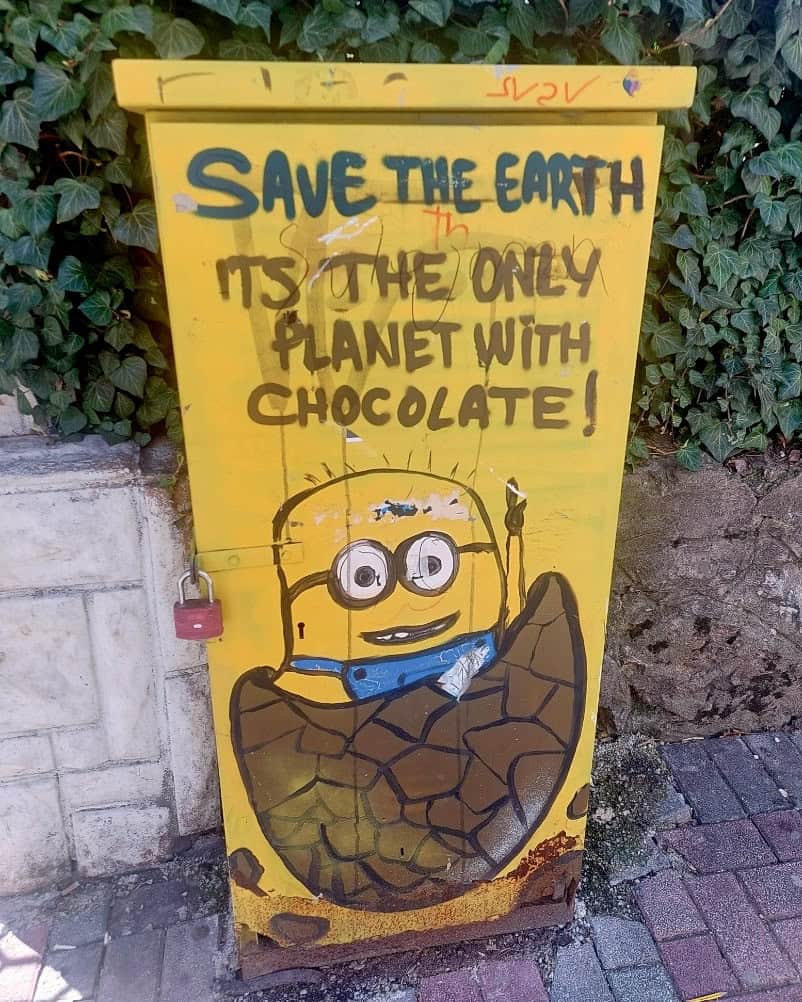
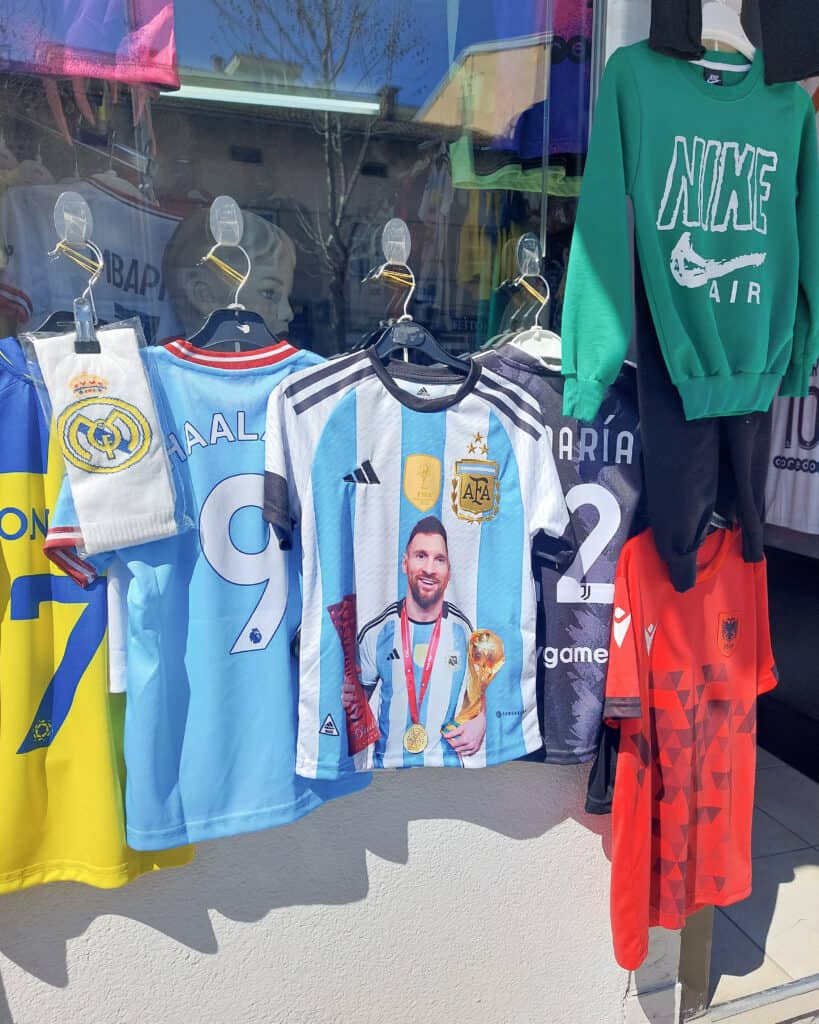
And I know fake football shirts are everywhere, but they make me smile and remember the holiday purchases when our sons were young and travelled with us. We have so many memories and stories about those shirts!
Lunch stop (Our Choice – Punto Verde)
While there are authentic Balkan dining experiences in Tetovo, we opted for an Italian, which seemed to be the most popular sort of food in Tetovo. Excellent ‘Macedonian style’ pasta which we paired with a bottle of Tikveš Alexandria semi-dry white. Macedonian wine is underrated and well worth sampling. Our meal for two plus wine came to about 1,760 MKD (approx £24/€28 with the wine making up the majority of the bill!

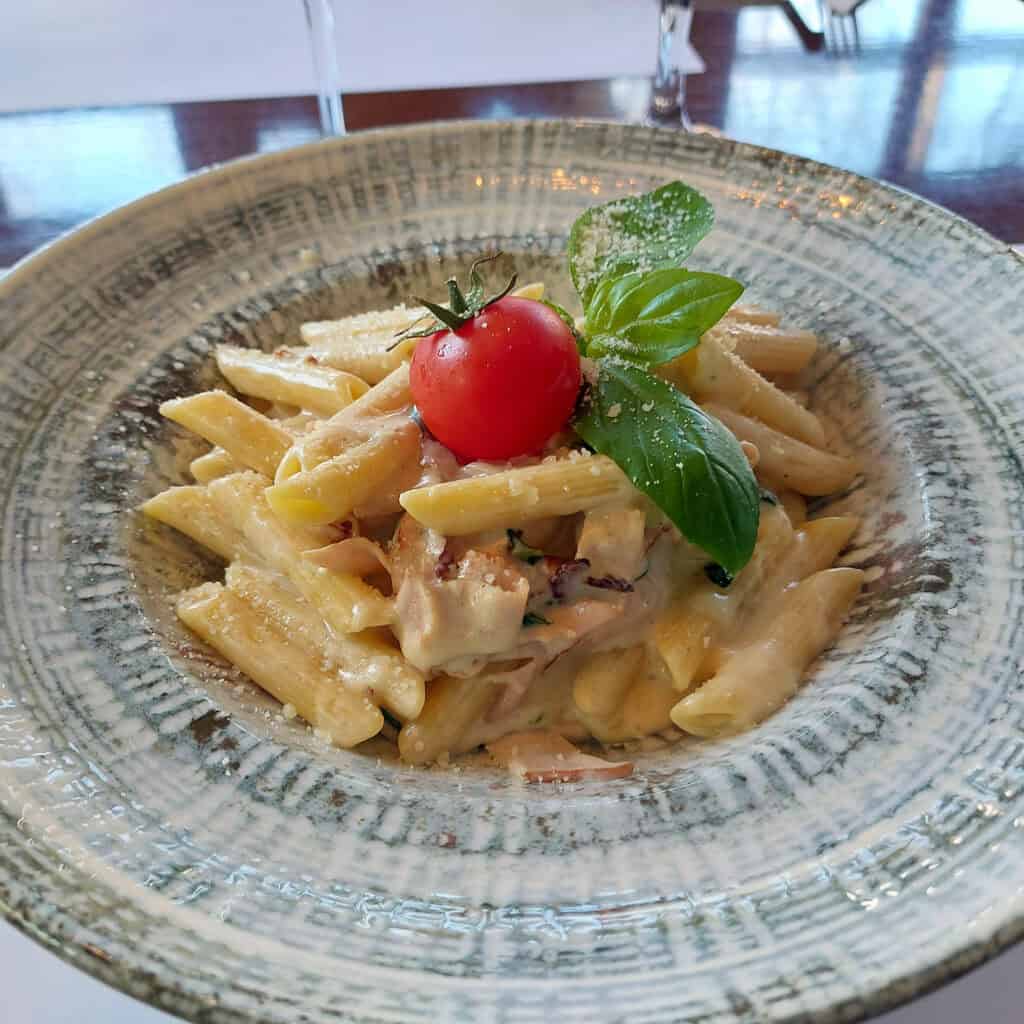
After lunch, we made our way back to the bus station, for the ride back to Skopje.
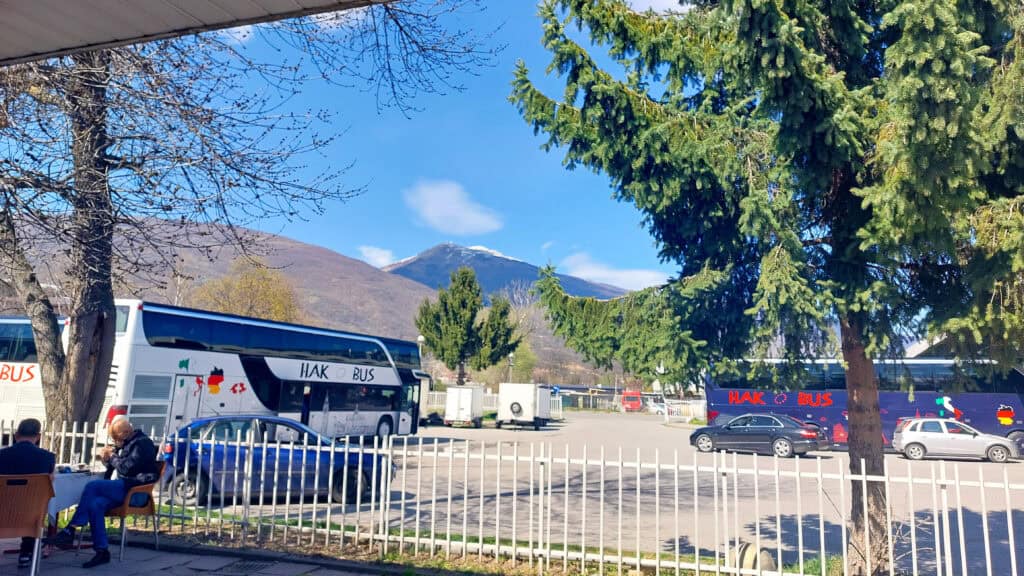
If You Stay Longer
Here are some more options:
- Lešok Monastery – A 14th-century monastery with frescoes, a short taxi ride out of town.
- Tetovo City Museum – Small but central, a quick way to add some local history context.
- Popova Šapka – Both a ski centre and summer trailhead just 15-20km above Tetovo. In winter, it’s known for freeride/cat-skiing. A few international skiers do come for the powder, but it’s not a huge resort like, say, Bansko in Bulgaria. In the summer, the resort becomes a base for hikes in the Sar mountains. The classic route is Titov Vrv (2,748m) and North Macedonia’s second highest peak. There are also shorter walks with big views.
- Kale (Baltepe) Fortress – A ruined hilltop fort with sweeping views, about 15–20 minutes’ uphill walk. We were warned it’s not very easy or safe to wander around. It’s not an obvious attraction like the fortresses in Skopje or Prizren.
Where to Stay in Tetovo
Tetovo would be a good place to break your journey up if you are visiting both Ohrid and Skopje. Here are some accommodation options.
If you’ve got this far, you may be interested in a trip to Mount Vodno and the Millennium Cross, also a bus trip from central Skopje and Best Things to Do in Skopje: Your Comprehensive Travel Guide to Europe’s Most Kitsch Capital. I’m also about to write up my trips over the border into Kosovo, so do subscribe if you’d like updates. I will only be mailing out about once a month, so I won’t be bombarding you.
Have you visited Tetovo and North Macedonia? Are you planning a visit? Let me know in the comments.
Thanks for Reading. And still curious? Here’s some top posts from the One Small Bag blog.
-
Everything You Need to Know Before Visiting Liechtenstein
Are you thinking about visiting Liechtenstein? Or maybe you need to know more before deciding? Here’s everything you need to…
-
Minimalist Travel Essentials: My Top 15 Tiny Travel Accessories
Packing light may sound straightforward, but it took a lot of practice and mistakes to refine and get to the…
-
Lightweight Tech for Travel: What to Pack and What to Skip
While we want to capture every moment, stay connected, and maybe squeeze in some remote work, it’s easy for tech…